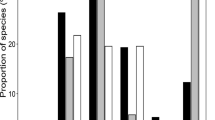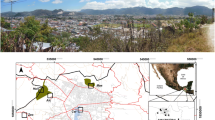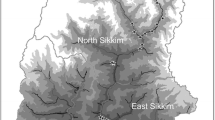Abstract
Land cover and climate change are both major threats for biodiversity. In mountain ecosystems species have to adapt to fragmented habitats and harsh environmental conditions but so far, altitudinal effects in combination with land cover change have been rarely studied. The objective of this study was to determine the effects of altitude and historical land cover change on butterfly diversity. We studied species richness patterns of butterflies occuring in wetlands and other open habitats along an altitudinal gradient in a low mountain region (340–750 m a.s.l., Bavaria, Germany) with drastic loss of open habitats within the last 40–60 years. We recorded in 27 sites a total of 4,523 individuals of 49 butterfly species and five species of burnet moths. Species richness peaked at mid elevation and increased with patch size. Land cover change was most pronounced at high altitudes, but neither current open habitats, nor the historical loss of open habitats affected the species richness of butterflies. Neither open land specialized butterflies nor generalist and forest species were significantly affected by the loss of open habitats. However, increasing forest area in high altitudes reduces possible refuge open habitats for butterflies at their thermal distribution limits. This could lead to extinction of such butterfly species when temperatures further rise due to global warming.



Similar content being viewed by others
References
Berg MP, Kiers ET, Driessen G, Van der Heijden M, Kooi BW, Kuenen F, Liefting M, Verhoef HA, Ellers J (2010) Adapt or disperse: understanding species persistence in a changing world. Glob Chang Biol 16:587–598
Berner D, Korner C, Blanckenhorn WU (2004) Grasshopper populations across 2000 m of altitude: is there life history adaptation? Ecography 27:733–740
Brückmann SV, Krauss J, Steffan-Dewenter I (2010) Butterfly and plant specialists suffer from reduced connectivity in fragmented landscapes. J Appl Ecol 47:799–809
BUWAL (1990) Inventar der Flachmoore von nationaler Bedeutung. Bundesamt für Umwelt Wald und Landschaft, Bern
Cant ET, Smith AD, Reynolds DR, Osborne JL (2005) Tracking butterfly flight paths across the landscape with harmonic radar. Proc R Soc B 272:785–790
Clarke A, Gaston KJ (2006) Climate, energy and diversity. Proc R Soc B 273:2257–2266
Colwell RK (2009) EstimateS: statistical estimation of species richness and shared species from samples. Version 8.2. User’s guide and application. http://purl.oclc.org/estimates
Colwell RK, Lees DC (2000) The mid-domain effect: geometric constraints on the geography of species richness. Trends Ecol Evol 15:70–76
Colwell RK, Rahbek C, Gotelli NJ (2004) The mid-domain effect and species richness patterns: what have we learned so far? Am Nat 163:E1–E23
Cozzi G, Müller CB, Krauss J (2008) How do local habitat management and landscape structure at different spatial scales affect fritillary butterfly distribution on fragmented wetlands? Landsc Ecol 23:269–283
Crawley MJ (2007) The R book. Wiley, Chichester
Ebert G, Rennwald E (1994) Die Schmetterlinge Baden-Württembergs. Band 3. Nachtfalter, Ulmer, Stuttgart
Erwin KL (2009) Wetlands and global climate change: the role of wetland restoration in a changing world. Wetl Ecol Manag 17:71–84
ESRI (1995) ArcView GIS for Windows, version 3.2. ESRI, Redlands, CA
Ewers RM, Didham RK (2006) Confounding factors in the detection of species responses to habitat fragmentation. Biol Rev 81:117–142
Fahrig L, Baudry J, Brotons L, Burel FG, Crist TO, Fuller RJ, Sirami C, Siriwardena GM, Martin JL (2011) Functional landscape heterogeneity and animal biodiversity in agricultural landscapes. Ecol Lett 14:101–112
Fleishman E, Fay JP, Murphy DD (2000) Upsides and downsides: contrasting topographic gradients in species richness and associated scenarios for climate change. J Biogeogr 27:1209–1219
Forister ML, McCall AC, Sanders NJ, Fordyce JA, Thorne JH, O’Brien J, Waetjen DP, Shapiro AM (2010) Compounded effects of climate change and habitat alteration shift patterns of butterfly diversity. PNAS 107:2088–2092
Franco AMA, Hill JK, Kitschke C, Collingham YC, Roy DB, Fox R, Huntley B, Thomas CD (2006) Impacts of climate warming and habitat loss on extinctions at species’ low-latitude range boundaries. Glob Chang Biol 12:1545–1553
Franzen M, Öckinger E (2012) Climate-driven changes in pollinator assemblages during the last 60 years in an arctic mountain region in northern Scandinavia. J Insect Conserv 16:227–238
Hodkinson ID (2005) Terrestrial insects along elevation gradients: species and community responses to altitude. Biol Rev 80:489–513
Hoiss H, Krauss J, Potts SG, Roberts S, Steffan-Dewenter I (2012) Altitude acts as an environmental filter on phylogenetic composition, traits and diversity in bee communities. Proc R Soc B 279:4447–4456
Inouye DW, Barr B, Armitage KB, Inouye BD (2000) Climate change is affecting altitudinal migrants and hibernating species. PNAS 97:1630–1633
IPCC (Intergovernmental Panel on Climate Change) (2007) Fourth assessment report. Climate change 2007. Working group I: the physical science basis. Cambridge University Press, Cambridge
Konvicka M, Maradova M, Benes J, Fric Z, Kepka P (2003) Uphill shifts in distribution of butterflies in the Czech Republic: effects of changing climate detected on a regional scale. Glob Ecol Biogeogr 12:403–410
Körner C (2007) The use of altitude in ecological research. Trends Ecol Evol 22:569–574
Krauss J, Steffan-Dewenter I, Tscharntke T (2003) How does landscape context contribute to effects of habitat fragmentation on diversity and population density of butterflies? J Biogeogr 30:889–900
Krauss J, Bommarco R, Guardiola M, Heikkinen RK, Helm A, Kuussaari M, Lindborg R, Öckinger E, Partel M, Pino J, Poyry J, Raatikainen KM, Sang A, Stefanescu C, Teder T, Zobel M, Steffan-Dewenter I (2010) Habitat fragmentation causes immediate and time-delayed biodiversity loss at different trophic levels. Ecol Lett 13:597–605
Kuussaari M, Bommarco R, Heikkinen RK, Helm A, Krauss J, Lindborg R, Öckinger E, Partel M, Pino J, Roda F, Stefanescu C, Teder T, Zobel M, Steffan-Dewenter I (2009) Extinction debt: a challenge for biodiversity conservation. Trends Ecol Evol 24:564–571
Leidner AK, Haddad NM (2011) Combining measures of dispersal to identify conservation strategies in fragmented landscapes. Conserv Biol 25:1022–1031
Lütolf M, Bolliger J, Kienast F, Guisan A (2009) Scenario-based assessment of future land use change on butterfly species distributions. Biodivers Conserv 18:1329–1347
Matter SF, Roland J, Moilanen A, Hanski I (2004) Migration and survival of Parnassius smintheus: detecting effects of habitat for individual butterflies. Ecol Appl 14:1526–1534
Mihoci I, Hrsak V, Kucinic M, Stankovic VM, Delic A, Tvrtkovic N (2011) Butterfly diversity and biogeography on the Croatian karst mountain Biokovo: vertical distribution and preference for altitude and aspect? Eur J Entomol 108:623–633
Naumann CM, Tarmann GM, Tremewan WG (1999) The western palaearctic zygaenidae. Apollo Books, Stenstrup
Nogues-Bravo D, Araujo MB, Romdal T, Rahbek C (2008) Scale effects and human impact on the elevational species richness gradients. Nature 453:216-U8
Öckinger E, Bergman KO, Franzen M, Kadlec T, Krauss J, Kuussaari M, Poyry J, Smith HG, Steffan-Dewenter I, Bommarco R (2012) The landscape matrix modifies the effect of habitat fragmentation in grassland butterflies. Landsc Ecol 27:121–131
Peintinger M, Bergamini A, Schmid B (2003) Species–area relationships and nestedness of four taxonomic groups in fragmented wetlands. Basic Appl Ecol 4:385–394
Pollard E (1977) Method for assessing changes in abundance of butterflies. Biol Conserv 12:115–134
R Development Core Team (2012) R: a language and environment for statistical computing. R Foundation for Statistical Computing, Vienna
Rosenzweig ML (1995) Species diversity in space and time. Cambridge University Press, Cambridge
Schultz CB, Franco AMA, Crone EE (2012) Response of butterflies to structural and resource boundaries. J Anim Ecol 81:724–734
Scriber JM (2010) Integrating ancient patterns and current dynamics of insect-plant interactions: taxonomic and geographic variation in herbivore specialization. Insect Sci 17:471–507
Settele J, Steiner R, Reinhardt R, Feldmann R (2005) Schmetterlinge, die Tagfalter Deutschlands. Ulmer Verlag, Stuttgart
Stefanescu C, Carnicer J, Penuelas J (2011) Determinants of species richness in generalist and specialist Mediterranean butterflies: the negative synergistic forces of climate and habitat change. Ecography 34:353–363
Steffan-Dewenter I, Tscharntke T (2000) Butterfly community structure in fragmented habitats. Ecol Lett 3:449–456
Stegen JC, Enquist BJ, Ferriere R (2009) Advancing the metabolic theory of biodiversity. Ecol Lett 12:1001–1015
Thomas CD, Cameron A, Green RE, Bakkenes M, Beaumont LJ, Collingham YC, Erasmus BFN, De Siqueira MF, Grainger A, Hannah L, Hughes L, Huntley B, Van Jaarsveld AS, Midgley GF, Miles L, Ortega-Huerta MA, Peterson AT, Phillips OL, Williams SE (2004) Extinction risk from climate change. Nature 427:145–148
Thuiller W (2007) Biodiversity—climate change and the ecologist. Nature 448:550–552
Tscharntke T, Klein AM, Kruess A, Steffan-Dewenter I, Thies C (2005) Landscape perspectives on agricultural intensification and biodiversity–ecosystem service management. Ecol Lett 8:857–874
Tscharntke T, Tylianakis JM, Rand TA, Didham RK, Fahrig L, Batary P, Bengtsson J, Clough Y, Crist TO, Dormann CF, Ewers RM, Frund J, Holt RD, Holzschuh A, Klein AM, Kleijn D, Kremen C, Landis DA, Laurance W, Lindenmayer D, Scherber C, Sodhi N, Steffan-Dewenter I, Thies C, Van Der Putten WH, Westphal C (2012) Landscape moderation of biodiversity patterns and processes—eight hypotheses. Biol Rev 87:661–685
Van Swaay C, Warren M, Lois G (2006) Biotope use and trends of European butterflies. J Insect Conserv 10:189–209
Walther GR, Post E, Convey P, Menzel A, Parmesan C, Beebee TJC, Fromentin JM, Hoegh-Guldberg O, Bairlein F (2002) Ecological responses to recent climate change. Nature 416:389–395
Warren MS, Hill JK, Thomas JA, Asher J, Fox R, Huntley B, Roy DB, Telfer MG, Jeffcoate S, Harding P, Jeffcoate G, Willis SG, Greatorex-Davies JN, Moss D, Thomas CD (2001) Rapid responses of British butterflies to opposing forces of climate and habitat change. Nature 414:65–69
Westphal C, Bommarco R, Carre G, Lamborn E, Morison N, Petanidou T, Potts SG, Roberts SPM, Szentgyorgyi H, Tscheulin T, Vaissiere BE, Woyciechowski M, Biesmeijer JC, Kunin WE, Settele J, Steffan-Dewenter I (2008) Measuring bee diversity in different European habitats and biogeographical regions. Ecol Monogr 78:653–671
Wilson RJ, Gutierrez D, Gutierrez J, Monserrat VJ (2007) An elevational shift in butterfly species richness and composition accompanying recent climate change. Glob Chang Biol 13:1873–1887
Acknowledgments
We thank Sabrina Brückmann and Konrad Loos for technical support. This project was supported by the Deutsche Forschungsgemeinschaft (Effects of climate change on altitudinal distribution, trophic interactions and genetic diversity of butterflies in low-mountain regions; Contract Number STE 957/8-1 to ISD and JK) and by the European Community‘s Seventh Framework Programme (FP7/2007–2013) under grant agreement no. 226852, Scales Project (http://www.scales-project.net).
Author information
Authors and Affiliations
Corresponding author
Electronic supplementary material
Below is the link to the electronic supplementary material.
Rights and permissions
About this article
Cite this article
Wagner, K.D., Krauss, J. & Steffan-Dewenter, I. Butterfly diversity and historical land cover change along an altitudinal gradient. J Insect Conserv 17, 1039–1046 (2013). https://doi.org/10.1007/s10841-013-9587-3
Received:
Accepted:
Published:
Issue Date:
DOI: https://doi.org/10.1007/s10841-013-9587-3




